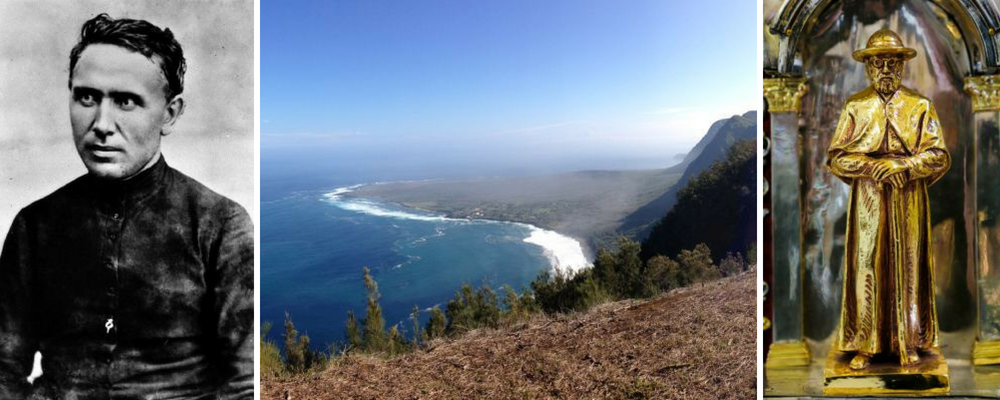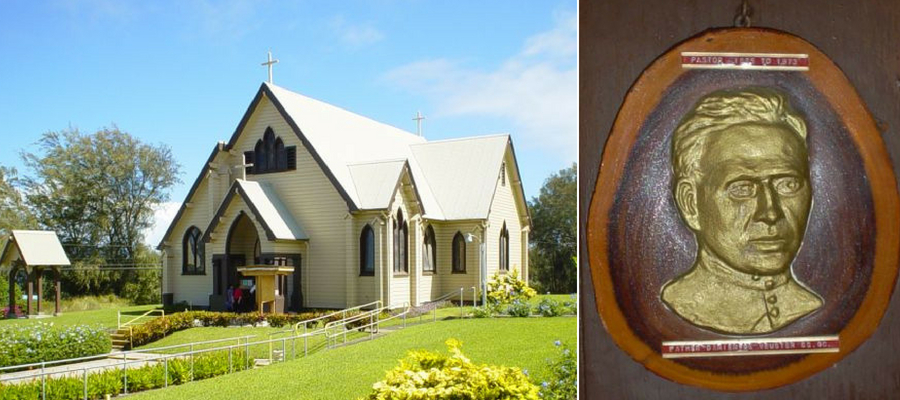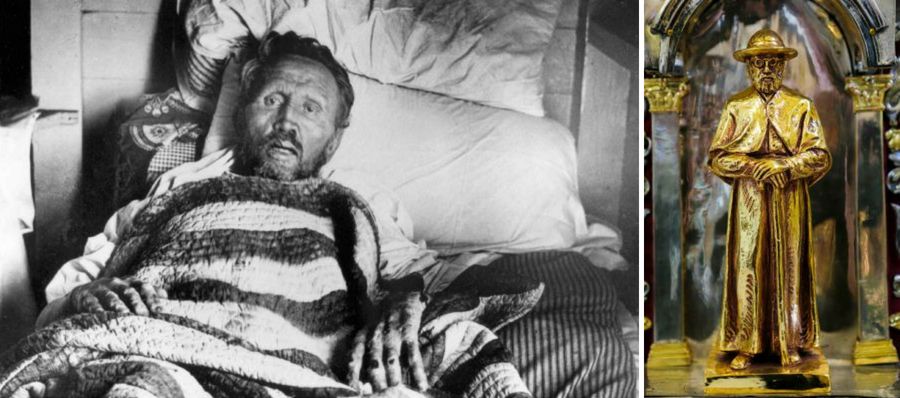
About Father Damien and Leprosy in Hawaii
Leprosy in Hawaii may have started with the arrival of immigrant workers in mid-1800’s. The native population didn’t have any immunity and easily contracted the disease, which was incurable at the time. In 1866 a colony was established on Molokai, on it’s northern side, on Kalaupapa peninsula, completely isolated by towering cliffs. A Belgian missionary priest Father Damien devoted last 16 years of his life to the lepers of Molokai, working every day to improve the despicable living conditions in this isolated colony.
About Father Damien
He was born Jozef De Veuster on January 3, January 1840, on a farm in rural Belgium. In 1860, he became Brother Damien in the Congregation of the Sacred Hearts of Jesus and Mary and started his studies to become a priest. When in 1863 his older brother, Father Pamphile, couldn’t go to Hawaii on a Sacred Hearts mission because of the illness, Damien was resolved to take his place and achieved his goal by petitioning the highest authority of the Congregation.
Damien arrived to Honolulu Harbor in Oahu on March 19, 1864. On May 21, 1864, he was ordained as Father Damien at the Cathedral of Our Lady of Peace, which was originally built by the Congregation of the Sacred Hearts of Jesus and Mary – Damien’s religious order. Before sailing to Molokai, Father Damien served in Maui, the Puna district on the Big Island, and from 1865 to 1873 he served as the pastor of the Kohala mission of Hawi, on the Big Island.

When the Bishop of the Honolulu diocese called for volunteer priests to serve in the leprosy colony of Molokai, 4 priests volunteered. Father Damien was given the “honor to establish the parish” and was the first priest to arrive at Kalaupapa on May 10, 1873. Though it was thought the the volunteer priests would change each other, Father Damien stayed in Kalaupapa until his death from leprosy on 15 April 1889, at the age of 49. Not only he served as priest, but he lived among the lepers as equal, teaching, organizing, dressing wounds, building houses and digging graves.
Father Damien was buried in Molokai. In 1936, his body was was returned to Belgium at the request of the Belgian king and government. In 1995, Father Damien was beatified and the remains of his right hand were returned to his original grave on Molokai. On Rosary Sunday, 11 October 2009, Father Damien was canonised as a saint during a ceremony in Rome. Father Damien’s life and work influenced many regardless of religion, including Robert Louis Stevenson and Mahatma Gandhi. And continue to impress and inspire.

About Leprosy, a.k.a. Hansen’s Disease
Leprosy is an infectious disease, caused by bacteria Mycobacterium leprae (M. leprae). It is also known as Hansen’s Disease (HD) after the name of a Norwegian physician, who identified this bacteria as the cause of the illness in 1873. It causes nerve damage and skin sores. Slowly growing, the infection can remain unnoticed from 5 to 20 years. When developed, Leprosy causes very unsightly sores and disfiguration of skin, that had always been the cause of terrible fear, despise and rejection of leprosy sufferers – lepers. While the outside appearance of leprosy patients can be extremely deformed, they don’t feel pain. Leprosy causes nerve damage and loss of the pain sensation, leading to infection of wounds as they tend to go unnoticed.
Leprosy was considered incurable and highly contagious. As a result, the patients were often isolated from the rest of the society. Today, we know that leprosy is not very contagious, and to get infected one would need to come into direct contact with mucous discharge of a leprosy patient. Leprosy is curable with antibiotics; the first antibiotic drug for leprosy was developed in 1940. More people get infected with leprosy in Africa and Asia. In the US 100-200 people are diagnosed with leprosy every year.
Leprosy in Hawaii
In 1852 began the immigration of Chinese sugar field workers to Hawaii, and it is believed that they brought leprosy to the islands. The Hawaiian name for the disease was Ma’i-Pake, which means Chinese sickness. The manifestation of the disease was unsightly and scary, the cause and the treatment – unknown. Hawaiian natives didn’t have immunity to foreign diseases and fell prey to them more easily.
On December 13, 1850, King Kamehameha III organized the first Board of Health, charged with protecting the people’s health from epidemic diseases. But leprosy was not under discussion until 1963, when the subject of Ma’i-Pake was officially raised for the first time. In 1865, King Kamehameha V approved “An Act to Prevent the Spread of Leprosy”, passed by the Legislative Assembly of the Hawaiian Islands. The law called for land to be set apart to isolate leprous persons, and the peninsula on the Molokai’s north shore seemed to be the perfect place for such a colony. Flat land was favorable for farming and raising livestock, the ocean – full of fish, and the whole peninsula – completely isolated by a vertical wall of cliffs up to 2000 feet high.
From now on, all people with suspected leprosy in Hawaii had to be examined and treated in a special medical detention facility on Oahu. If found to be in an advance stage of the disease, the patients had to be separated from their families and sent to the Kalaupapa settlement on Molokai for life. Such segregation conflicted with Hawaiian values and was deeply resented. In many cases it had to be forcibly conducted to protect healthy people.
The cliffs kept people from escaping. There was one very steep trail to the top and if someone had been able to make it all the way up, he’d be shot. At the same time the sea there is worse than anywhere else in Hawaii, so it wasn’t possible to escape by sea either. It was also very difficult to deliver supplies, as boats often could not go through the raging seas. Molokai “prisoners” sometimes were lucky to get supplies every two months.
By 1873, the year of Father Damien’s arrival to Kalaupapa to save souls, over 800 lepers lived in the settlement.
Interesting Facts
In the movie Molokai: The Story of Father Damien, Fr. Damien prays the first time on Kalaupapa: “Dear Lord, you died at 33. I begin my life at 33. I pray for your protection.”
Father Damien arrived at Kalaupapa settlement in 1873, the same year Norwegian physician Hansen identified Mycobacterium leprae (M. leprae) as the cause of leprosy.








7 thoughts on “About Father Damien and Leprosy in Hawaii”
Father Damien did what very few people would do. There was no cure for Leprosy and he would have known the disease would.eventually kill him but he/ still gave his heart, souls and body to the sick, diseased people. I am sure God blessed him with eternal life.
“About Father Damien and and Leprosy in Hawaii”. I have no idea what got me interested in Molokai Island which I heard back when I was very young at time and heard from my mother about it. It take a LOTS OF LOVE and self scarifies to care for the people who were suffering from this horrible disease. I cried. It is all about love. I read about Father Damien I could not stop my tears at the front of my husband. Love
I know most of the story from my Mother. I know about leprosy when they isolated to Molokai Island, because they think Molokai Island is the very perfect place for isolation for this horrible disease. I did recalled about the pneumonia in Utulei Island in Vavau, Tonga (The South Pacific) when I was very young and used to go visit my Grandma and Grandpa, and all my uncles in Utulei Island. My Mother got married to my Dad in the Village of Pangaimotu, Vavau in Tonga Island. I still remember the biggest Hurricane at the time when I was very little hiding in the Church building with my Mother during the hurricane and the palm trees and many houses were damage including the church building. I still remember the people were sick including my grandma and grandpa from Pneumonia at the time and they were getting better by very careful to not spread the disease when anybody got sick from pneumonia. When I watch the Walking dead movie I cry, remembering the horrible disease of leprosy in Molokai Island in Hawaii. I feel very sad and feel love for these people. Thank you for the very beautiful story. I was typing my comment and could not stop my tear as a TEARS OF LOVE. Love
Dear Luisa,
Thank you for your wonderful and loving comments! And your own story. It’s incredible how much good some people can do out of love. We are not all as gifted, but we can all learn something from selfless feats of humans driven by pure love.
Love and Peace!
I usually used this man of God Father Damien in my sermon illustrations like in Mark 1:30 says “So he went to her, took her hand and helped her up”
Contagious diseases have precautions like wearing latex gloves, masks and protective clothings to cover and to prevent. but Jesus went, came close to her and touched her by the hand
Father Damien was like Jesus, he knew the disease is contagious, but he went to show his love, live with them, eat with them and never came back. I love this true story of Father Damien, a true man of God
I have heard of this island Molokai in a song of one of the lepers from our island of Samoa who the family was trying to locate where is he taken, but little that they know is taken to Molokai a place isolated in Hawaii for lepers
Love and Peace on Earth